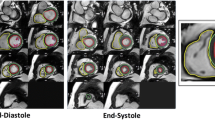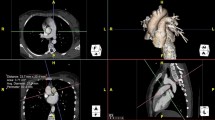Abstract
The aim of the study was to define normal ranges for thoracic aorta and pulmonary artery diameters relative to gender, age, body surface area (BSA) and body mass index (BMI) in healthy Chinese adults by cardiac magnetic resonance (CMR). We studied 200 healthy participants (100 men, 100 women; age range from 20–70) by using a 3.0-T CMR system. The diameters of the ascending aorta (AA), main pulmonary artery (PA), proximal descending aorta (DA) and Valsalva sinus (VAS) were measured manually by two experienced doctors on half-Fourier single-shot spin echo (HASTE) and balanced steady-state free precession (bSSFP) cine images. The mean value and age specific and gender adjusted normal limits were calculated. The linear regression analysis were performed between diameters and gender, age, BMI and BSA. The mean and 95% confidence interval(CI) of AA, PA, DA and VAS were 28.95 ± 4.61 mm(95% CI 19.92–37.99 mm), 22.41 ± 2.59 mm(95% CI 17.31–27.47 mm), 20.61 ± 2.96 mm(95% CI 14.81–26.42 mm), 31.15 ± 3.65 mm(95% CI 24.00–38.29 mm), respectively. The gender differences of all the parameters above were statistically significant (all p < 0.01). Both thoracic aorta and pulmonary artery dilates with the increase of age, while AA has the highest dilation rate. The mean PA/AA was 0.79 and showed no gender difference, but there was statistical difference among all age groups (p < 0.01). AA and DA had stronger association with age and BSA than BMI. Age- and gender-specific reference diameters of thoracic aorta and pulmonary artery were provided in healthy Chinese adults. Age and BSA have stronger effects on the ranges of diameters than BMI.





Similar content being viewed by others
Data availability
The datasets are available from the corresponding author on reasonable request.
References
Evangelista A (2010) Diseases of the aorta: aneurysm of the ascending aorta. Heart 96(12):979–985. https://doi.org/10.1136/hrt.2008.152751
Leontyev S, Misfeld M, Mohr FW (2014) Aneurysms of the ascending aorta and aortic arch. Chirurg 85(9):760–766. https://doi.org/10.1007/s00104-014-2716-z
Higgins CB, Stark D, McNamara M, Lanzer P, Crooks LE, Kaufman L (1984) Multiplane magnetic resonance imaging of the heart and major vessels: studies in normal volunteers. AJR Am J Roentgenol 142(4):661–667. https://doi.org/10.2214/ajr.142.4.661
Campens L, Demulier L, De Groote K, Vandekerckhove K, De Wolf D, Roman MJ, Devereux RB, De Paepe A, De Backer J (2014) Reference values for echocardiographic assessment of the diameter of the aortic root and ascending aorta spanning all age categories. Am J Cardiol 114(6):914–920. https://doi.org/10.1016/j.amjcard.2014.06.024
Guo JP, Jia X, Sai Z, Ge YY, Wang S, Guo W (2016) Thoracic Aorta Dimension Changes During Systole and Diastole: Evaluation with ECG-Gated Computed Tomography. Ann Vasc Surg 35:168–173. https://doi.org/10.1016/j.avsg.2016.01.050
Quint LE, Liu PS, Booher AM, Watcharotone K, Myles JD (2013) Proximal thoracic aortic diameter measurements at CT: repeatability and reproducibility according to measurement method. Int J Cardiovasc Imaging 29(2):479–488. https://doi.org/10.1007/s10554-012-0102-9
Vasan RS, Larson MG, Levy D (1995) Determinants of echocardiographic aortic root size. The Framingham Heart Study Circulation 91(3):734–740. https://doi.org/10.1161/01.cir.91.3.734
Roman MJ, Devereux RB, Kramer-Fox R, O’Loughlin J (1989) Two-dimensional echocardiographic aortic root dimensions in normal children and adults. Am J Cardiol 64(8):507–512. https://doi.org/10.1016/0002-9149(89)90430-x
Cohen GI, White M, Sochowski RA, Klein AL, Bridge PD, Stewart WJ, Chan KL (1995) Reference values for normal adult transesophageal echocardiographic measurements. J Am Soc Echocardiogr 8(3):221–230. https://doi.org/10.1016/s0894-7317(05)80031-8
Reed CM, Richey PA, Pulliam DA, Somes GW, Alpert BS (1993) Aortic dimensions in tall men and women. Am J Cardiol 71(7):608–610. https://doi.org/10.1016/0002-9149(93)90523-f
Danias PG, Tritos NA, Stuber M, Botnar RM, Kissinger KV, Manning WJ (2003) Comparison of aortic elasticity determined by cardiovascular magnetic resonance imaging in obese versus lean adults. Am J Cardiol 91(2):195–199. https://doi.org/10.1016/s0002-9149(02)03109-0
Mohiaddin RH, Schoser K, Amanuma M, Burman ED, Longmore DB (1990) MR imaging of age-related dimensional changes of thoracic aorta. J Comput Assist Tomogr 14(5):748–752. https://doi.org/10.1097/00004728-199009000-00012
Garcier JM, Petitcolin V, Filaire M, Mofid R, Azarnouch K, Ravel A, Vanneuville G, Boyer L (2003) Normal diameter of the thoracic aorta in adults: a magnetic resonance imaging study. Surg Radiol Anat 25(3–4):322–329. https://doi.org/10.1007/s00276-003-0140-z
Lange TJ, Dornia C, Stiefel J, Stroszczynski C, Arzt M, Pfeifer M, Hamer OW (2013) Increased pulmonary artery diameter on chest computed tomography can predict borderline pulmonary hypertension. Pulm Circ 3(2):363–368. https://doi.org/10.4103/2045-8932.113175
Lee SH, Kim YJ, Lee HJ, Kim HY, Kang YA, Park MS, Kim YS, Kim SK, Chang J, Jung JY (2015) Comparison of CT-Determined Pulmonary Artery Diameter, Aortic Diameter, and Their Ratio in Healthy and Diverse Clinical Conditions. PLoS ONE 10(5):e0126646. https://doi.org/10.1371/journal.pone.0126646
Mosteller RD (1987) Simplified calculation of body-surface area. N Engl J Med 317(17):1098. https://doi.org/10.1056/NEJM198710223171717
Davis AE, Lewandowski AJ, Holloway CJ, Ntusi NA, Banerjee R, Nethononda R, Pitcher A, Francis JM, Myerson SG, Leeson P, Donovan T, Neubauer S, Rider OJ (2014) Observational study of regional aortic size referenced to body size: production of a cardiovascular magnetic resonance nomogram. J Cardiovasc Magn Reson 16:9. https://doi.org/10.1186/1532-429X-16-9
Karazincir S, Balci A, Seyfeli E, Akoglu S, Babayigit C, Akgul F, Yalcin F, Egilmez E (2008) CT assessment of main pulmonary artery diameter. Diagn Interv Radiol 14(2):72–74
Kawel-Boehm N, Maceira A, Valsangiacomo-Buechel ER, Vogel-Claussen J, Turkbey EB, Williams R, Plein S, Tee M, Eng J, Bluemke DA (2015) Normal values for cardiovascular magnetic resonance in adults and children. J Cardiovasc Magn Reson 17:29. https://doi.org/10.1186/s12968-015-0111-7
Edwards PD, Bull RK, Coulden R (1998) CT measurement of main pulmonary artery diameter. Br J Radiol 71(850):1018–1020. https://doi.org/10.1259/bjr.71.850.10211060
Lin FY, Devereux RB, Roman MJ, Meng J, Jow VM, Jacobs A, Weinsaft JW, Shaw LJ, Berman DS, Gilmore A, Callister TQ, Min JK (2008) Assessment of the thoracic aorta by multidetector computed tomography: age- and sex-specific reference values in adults without evident cardiovascular disease. J Cardiovasc Comput Tomogr 2(5):298–308. https://doi.org/10.1016/j.jcct.2008.08.002
Turkbey EB, Jain A, Johnson C, Redheuil A, Arai AE, Gomes AS, Carr J, Hundley WG, Teixido-Tura G, Eng J, Lima JA, Bluemke DA (2014) Determinants and normal values of ascending aortic diameter by age, gender, and race/ethnicity in the Multi-Ethnic Study of Atherosclerosis (MESA). J Magn Reson Imaging 39(2):360–368. https://doi.org/10.1002/jmri.24183
Beck L, Mohamed AA, Strugnell WE, Bartlett H, Rodriguez V, Hamilton-Craig C, Slaughter RE (2018) MRI measurements of the thoracic aorta and pulmonary artery. J Med Imaging Radiat Oncol 62(1):64–71. https://doi.org/10.1111/1754-9485.12637
Potthast S, Mitsumori L, Stanescu LA, Richardson ML, Branch K, Dubinsky TJ, Maki JH (2010) Measuring aortic diameter with different MR techniques: comparison of three-dimensional (3D) navigated steady-state free-precession (SSFP), 3D contrast-enhanced magnetic resonance angiography (CE-MRA), 2D T2 black blood, and 2D cine SSFP. J Magn Reson Imaging 31(1):177–184. https://doi.org/10.1002/jmri.22016
Schlatmann TJ, Becker AE (1977) Histologic changes in the normal aging aorta: implications for dissecting aortic aneurysm. Am J Cardiol 39(1):13–20. https://doi.org/10.1016/s0002-9149(77)80004-0
Boraita A, Heras ME, Morales F, Marina-Breysse M, Canda A, Rabadan M, Barriopedro MI, Varela A, de la Rosa A, Tunon J (2016) Reference Values of Aortic Root in Male and Female White Elite Athletes According to Sport. Circ Cardiovasc Imaging. https://doi.org/10.1161/CIRCIMAGING.116.005292
Payo IM, Ongkana N, Tohno S, Azuma C, Minami T, Moriwake Y, Tohno Y (2007) Moderate accumulation of calcium and phosphorus in the splenic artery with aging and low accumulation of those in the pulmonary artery with aging. Biol Trace Elem Res 119(2):103–110. https://doi.org/10.1007/s12011-007-0052-6
Lederle FA, Johnson GR, Wilson SE, Chute EP, Littooy FN, Bandyk D, Krupski WC, Barone GW, Acher CW, Ballard DJ (1997) Prevalence and associations of abdominal aortic aneurysm detected through screening Aneurysm Detection and Management (ADAM) Veterans Affairs Cooperative Study Group. Ann Intern Med 126(6):441–449. https://doi.org/10.7326/0003-4819-126-6-199703150-00004
Redheuil A, Yu WC, Wu CO, Mousseaux E, de Cesare A, Yan R, Kachenoura N, Bluemke D, Lima JA (2010) Reduced ascending aortic strain and distensibility: earliest manifestations of vascular aging in humans. Hypertension 55(2):319–326. https://doi.org/10.1161/HYPERTENSIONAHA.109.141275
Burman ED, Keegan J, Kilner PJ (2008) Aortic root measurement by cardiovascular magnetic resonance: specification of planes and lines of measurement and corresponding normal values. Circ Cardiovasc Imaging 1(2):104–113. https://doi.org/10.1161/CIRCIMAGING.108.768911
Funding
This study was supported by the Research Grant of Construction Research Project of Key Laboratory (Cultivation) of the Chinese Academy of Medical Sciences (2019PT310025), Capital’s Funds for Health Improvement and Research (CFH 2020-2-4034), Capital Clinically Characteristic Applied Research Fund (Z191100006619021), Clinical and Translational Fund of Chinese Academy of Medical Sciences (2019XK320063), National Natural Science Foundation of China (81771811 and 81971588) and Graduate Innovation Fund of Peking Union Medical College, China (2019-1002-74).
Author information
Authors and Affiliations
Contributions
Guarantor of integrity of the entire study: ML study design ML literature research: SL and BZ image and data acquisition, collection and analysis GY, XY, SL and BZ statistical analysis: SL and BZ manuscript preparation: SL and BZ manuscript editing ML and SZ.
Corresponding author
Ethics declarations
Conflicts of interest
All authors declare that they have no conflict of interest.
Additional information
Publisher's Note
Springer Nature remains neutral with regard to jurisdictional claims in published maps and institutional affiliations.
Rights and permissions
About this article
Cite this article
Li, S., Zhuang, B., Yin, G. et al. Reference values of thoracic aorta and pulmonary artery diameters by age and gender in healthy Chinese adults assessed by cardiac magnetic resonance imaging: data from national center for cardiovascular diseases of China. Int J Cardiovasc Imaging 37, 1423–1431 (2021). https://doi.org/10.1007/s10554-020-02116-9
Received:
Accepted:
Published:
Issue Date:
DOI: https://doi.org/10.1007/s10554-020-02116-9




